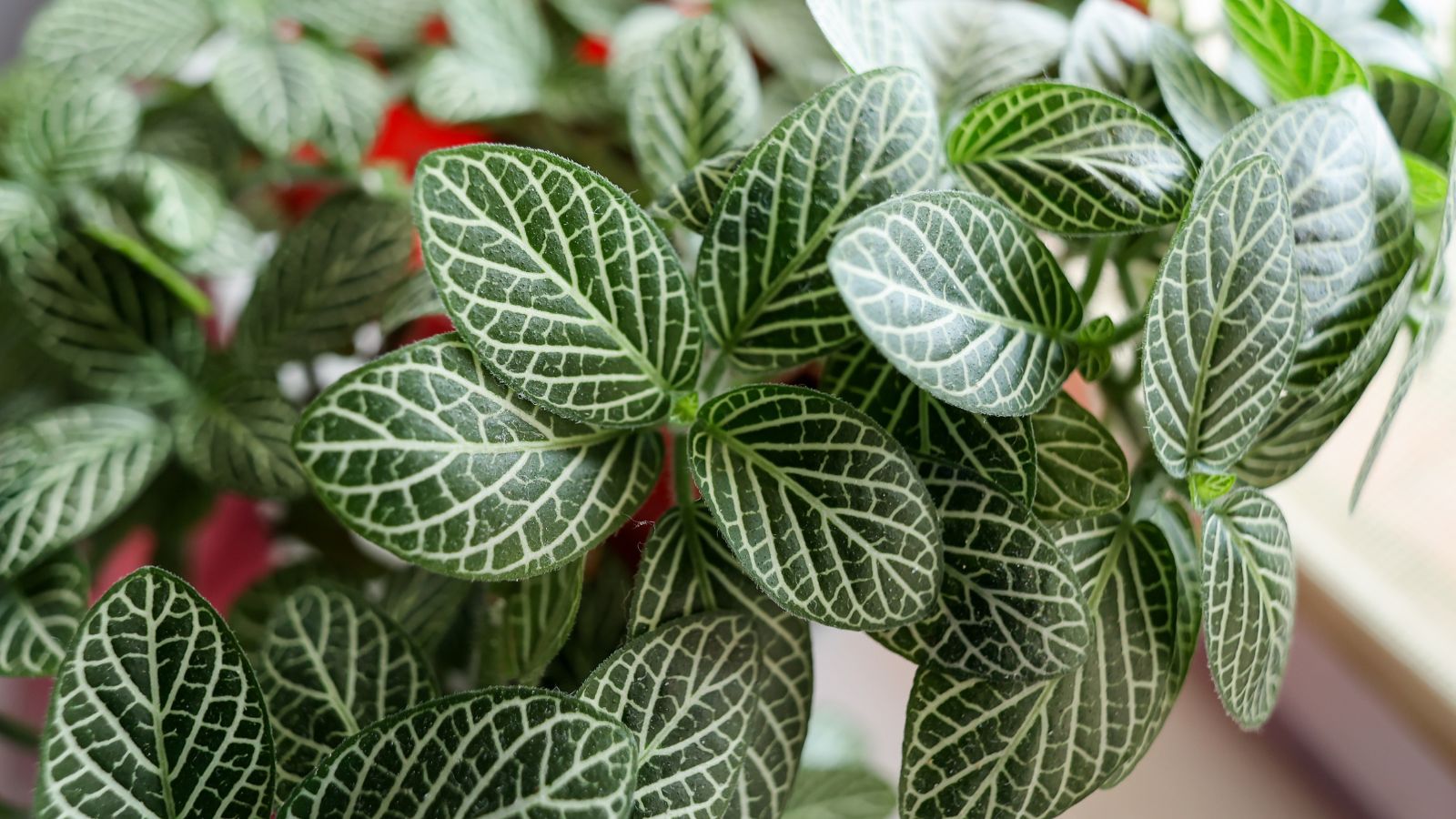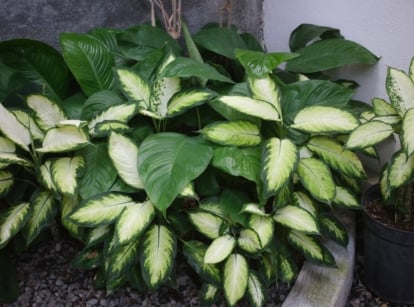How to Plant, Grow, and Care for Nerve Plant
Fittonia, usually called the nerve plant, is a fascinating houseplant with different-colored foliage. It is great in pots and terrariums. In this guide, Kelli Klein explains how to grow and care for Fittonia.

Contents
The nerve plant is a tropical species that rarely flowers when grown as a houseplant, but it has unique and stunning foliage. The intricate leaf veins add a pop of color to the dark green leaves. Nerve plants also add interest to your indoor houseplant collection and do well in hanging baskets. There are many different types, including a large-leaf variety and mini white nerve plants.
Nerve plants are not difficult to care for. However, they can be temperamental and have specific humidity and climate requirements. It makes sense that these tropical species require high humidity and moist but not waterlogged soil. Providing this lush tropical perennial with ideal growing conditions will reward you with beautiful houseplants that showcase their dark green leaves with either red or white veins. Read on to learn all about nerve plant care.
To better understand nerve plant care, it helps to know how they grow in their native habitat. These tropical species grow in the understory of rainforests. Therefore, they grow best in indirect sunlight since they’re used to being shaded by taller surrounding trees and fauna. Propagating nerve plants from stem cuttings is also very easy, so if you love this mosaic plant, you can easily turn it into many more!
Plant Overview

|
Plant
Houseplant
Family
Acanthaceae
Genus
Fittonia
Species
Fittonia albivenis
|
Native Area
Northern South America
Exposure
Bright, indirect light
Height
3-6″
Watering Requirements
Regular
|
Pests & Diseases
Aphids, thrips, root rot, mosaic virus
Maintenance
Low
Soil Type
Potting soil
Hardiness Zone
11-12
|
What are Nerve Plants?
The nerve plant (Fittonia albivenis) is also known as silver net plant, painted net leaf plant, and mosaic plant. There are many different fittonia plant cultivars, including the juanita nerve plant and ruby red fittonia plants. Mosaic plants make an excellent addition to your indoor garden alongside other indoor plants. Commonly grown as houseplants, they are known for their beautiful leaf coloring patterns. You can find many cultivars of the nerve plant online, too!
Native Area

These herbaceous evergreen perennials originate from the rainforests of Colombia, Peru, Bolivia, Ecuador, and northern Brazil. They grow under the canopy of tropical trees in warm humid environments.
Characteristics

The rich green leaves generally showcase either bright white veins, richly red-colored veins, or even pinkish-red veins. Sometimes they don gray-green leaves with dark green edges with white veins. Though they can also come in colors like pink and magenta. Most varieties have smaller leaves, although there is also a large leaf fittonia variety.
Planting

To plant a nerve plant, choose a pot with drainage holes at least four to six inches in diameter to allow room for root growth. Fill the pot with well-draining, peat-based potting soil, leaving about one inch of space from the rim. If transplanting, gently remove the fittonia from its nursery container, loosen the roots slightly, and place it in the new pot at the same depth it was previously growing. Fill in with soil, pressing lightly to remove air pockets, and water thoroughly until excess water drains out.
Place the pot in bright, indirect light and maintain humidity by misting the leaves or using a pebble tray.
How to Grow
Fittonia nerve plant care requires a specific set of growing conditions. It can be temperamental and tricky to grow as a houseplant. Provide these tropical houseplants with their ideal environment to keep these plants healthy and happy!
Light

One of the biggest mistakes that can be made when growing a nerve plant is to place them in direct sun. Too much light can cause muted leaf veins and, in severe cases, can cause the leaves to drop. In addition, it does not tolerate dry air and cold temperatures (from drafty locations). It grows best in bright indirect light with temperatures around 70°F (21°C) with constant humidity.
Water

As mentioned above, nerve plants prefer high humidity. A humid environment can be created by using an indoor houseplant humidifier since they require high humidity that can’t be found in most homes. They are happiest at 50-70% humidity. They also prefer to be kept evenly moist but not waterlogged. Overwatering can cause just as many issues as underwatering. For this reason, grow in a pot with a drainage hole to avoid standing water. Let the top inch of soil dry out completely between waterings. In the winter, when growth slows down, you may need to water less frequently.
Soil

The ideal potting mix for nerve plants has good drainage but retains some moisture. In order to create a moist potting mix and avoid poor drainage, a peat-based mix with added perlite, such as African violet potting mix, can be used. If you find yourself with drainage issues, then you may choose to add some coarse sand to your nerve plant potting mixture. It’s very important to prevent soggy soil. If you begin to see signs of overwatering (drooping yellow leaves, mushy stems), it’s better to repot into fresh soil rather than lose them altogether. They can tolerate neutral soil but do best in a slightly acidic potting mix.
Temperature

Nerve plants can be grown outdoors in USDA growing zone 11. In all other growing zones, it will be an indoor houseplant. However, when nighttime temperatures are above 65°F (18°C), and daytime temperatures are between 75-85°F (24-29°C), they can be placed outdoors temporarily. They are extremely frost-tender and will not survive cold temperatures. If you choose to move your nerve plant outdoors during the warmer months, keep in mind that they will still need to avoid direct sunlight, or they may suffer leaf burn.
Fertilizing

During the growing season, nerve plants benefit from a liquid fertilizer formulated for tropical houseplants. A balanced fertilizer diluted to half strength works best. Feed them once a month during the spring and summer months for the best results.
Maintenance

Nerve plants can become tall, leggy, and unruly, and at this point, they benefit from a “haircut” or pruning. They can be pruned much like others that are commonly grown indoors. Cut back to your desired height, and be sure to cut at a leaf node. This will promote bushier growth. The stem tip cuttings can then be used to propagate another one. Read on to learn about propagation best practices!
Repot every two to three years. If the leaves begin turning yellow and limp, then that is a sign of waterlogged soil due to poor drainage. If this is the case, then it’s best to repot your nerve plant into fresh soil with better drainage. At this point, make sure you remove any soggy or damaged roots. See the soil section above for specifics on what type of soil can provide better drainage.
Propagation

As mentioned above, after you prune, this gives you the perfect opportunity to propagate. Take a cutting at a leaf node. Be sure that it is at least several inches tall. Remove the lower leaves and stick the stem end into a glass of water. Roots will appear over the next few weeks. After the roots have appeared, you can transplant them into fresh potting soil.
Common Problems
As mentioned above, the nerve plant can be quite temperamental, and most growing issues are the result of too much moisture, direct sun, and not enough humidity.
Growing Problems

Nerve plants grow best in indirect sunlight. Direct sunlight can result in browning leaves from sun scorch. If you notice that the leaves begin to brown and drop or if they no longer has deep green leaves like when you first purchased it, it could be a sign that it is receiving too much sunlight. Move it to an area that receives bright indirect light, and the green foliage should bounce back.
In dry climates, they may complain about too little humidity. This can appear as wilting leaves or general plant distress – it looks lackluster and unhappy. Adding a pebble tray beneath your pot can help. A tray with pebbles and water keeps the base of the pot above the surface of the water but allows for evaporative moisture to reach the roots, increasing the humidity right around it.
Pests

Aphids are the most common pest for young nerve plants because they love to feed on new growth. It’s best to isolate the affected houseplant to avoid spreading. When the weather permits, place it outdoors and give a blast of water to remove the aphids. This should be enough. However, you may choose to leave them outdoors for a few weeks to allow predatory insects like ladybugs, paper wasps, etc to take care of any straggler aphids. If a blast of water does not eliminate the aphids, consider organic alternatives like neem oil, or insecticidal soap.
Thrips are very tiny and sometimes not easily visible to the naked eye. As thrips consume stems and leaves, they leave behind dust-like poop giving the foliage a silvery sheen. As with aphids, you can place the pot outdoors to encourage predatory insects to take care of the infestation, such as parasitic wasps and lacewing larvae. In more advanced infestations, neem oil, and insecticidal soaps can be used.
Diseases

Root rot is caused by fungi that dwell in overly moist soil. Root rot is the main disease that can affect nerve plants. The symptoms of this disease appear as a soft mushy stem, wilting, and of course, rotten roots. This type of rot is harder to recover from but can be remedied if there are still fresh, white roots that have not yet turned to mush. Cut back the rotted roots and replant the into a pot of dry soil.
Nerve plant mosaic virus binds to a receptor on the cell wall and presents the receptor with the keys to gain access to the cell. The virus hijacks the cell with viral genetic information in order to replicate. The infected tissue dies as the virus spreads throughout the entire shrub. An affected fittonia is a threat to others nearby as this virus can spread through leaf-to-leaf contact, and it should be removed and destroyed immediately as there is no cure for this virus. Symptoms of the mosaic virus will appear as blotchy light and dark green or yellow mottling on foliage and distorted leaves. To prevent future viral outbreaks, be sure to sanitize pruning shears when cutting different houseplants.
Frequently Asked Questions
Are nerve plants easy to care for?
They are not difficult to care for per se, but their specific care requirements might not be the best choice for beginner gardeners or those looking for a low-maintenance houseplant.
Does nerve plant need sunlight?
Yes, but they have low to medium light requirements and do best with bright indirect light.
Are nerve plants toxic to humans?
They are not toxic to humans and are pet friendly.
How often should you water a nerve plant?
Every three to four days during the growing season, less so in the winter. Allow the top inch of soil to dry out between waterings.
Is nerve plant indoor or outdoor?
Nerve plants can only be grown outdoors in tropical regions. In the rest of the world, they are usually grown as indoor plants.
How do you make a nerve plant bushier?
Prune back leggy stems to promote bushier growth.
Why is my nerve plant dropping leaves?
There may be a variety of reasons, including too much sun, drying out, overwatering, or low humidity.
Should I cut the flowers off my nerve plant?
This is up to you. Allowing it to flower will take the energy away from the foliage, and most grow this variety for the foliage. You can snip the flower spikes once they appear to allow the plant to focus on foliar growth.









